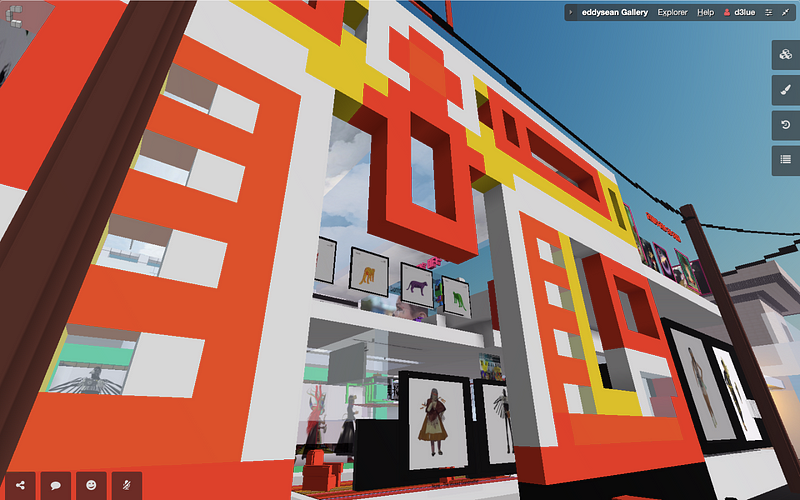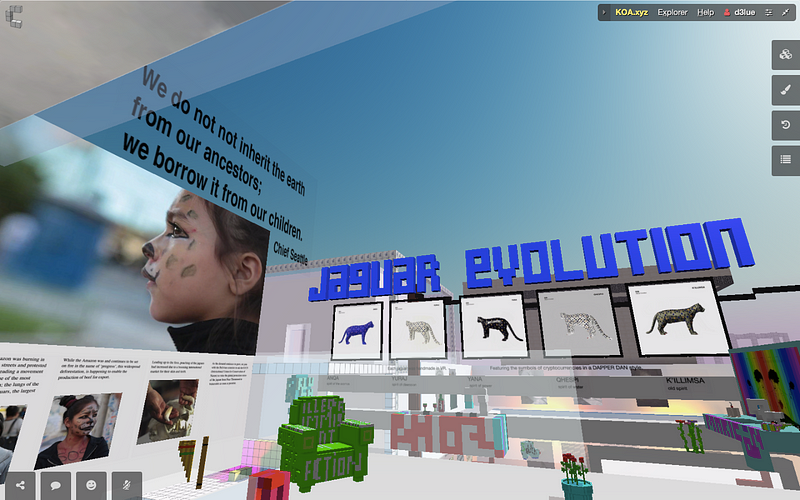Depending on who you ask and what you read, the metaverse is the future of all media making and will provide a revolutionary labor platform. What will that mean for the future of independent artists?
 Screenshot of
the entrance to KOA’s gallery, with a view of the ground and upper floor gallery displays. Image
courtesy of Violeta Ayala
Screenshot of
the entrance to KOA’s gallery, with a view of the ground and upper floor gallery displays. Image
courtesy of Violeta AyalaSince 2015, filmmaker, writer, artist, and technologist Violeta Ayala began developing projects in virtual reality, generated from the creative point of view of a South American indigene. A Bolivian Quechuan, Ayala is currently working with partners scattered across Europe and South America. Collectively known as KOA.xyz, this aggregate of artists created their own virtual gallery in Cryptovoxels, a virtual world powered by Ethereum currency blockchain where anyone can buy land and build exhibition spaces and stores. In KOA’s case, they built a gallery to display their own work, as well as to curate programs to showcase the work of fellow Andean artists. Cryptovoxels’ foundational business model can also be found in such worlds as Decentraland, The Sandbox, Somnium Space, and Axie Infinity.
During the 2021 Sundance Film Festival, where the first episode of Ayala’s VR animation, Prison X, had its premiere, a panel on Clubhouse sparked Ayala’s curiosity about blockchain tech. After experiencing Sundance’s virtual offerings, which included a proximity-enabled social VR hangout space called Film Party, she wanted to build her own space. Ayala explains, “We discussed the possibilities of other platforms but that meant building in the virtual spaces of huge corporations such as Facebook and Google. After learning that the Sundance Film Festival wanted to avoid that and own and build its own spaces, we wanted to do the same. […] We factored the costs of building a professional website into our purchase of the virtual space. If we used ‘free’ spaces, we’d end up paying with our privacy, spaces where, before you realize it, you’ve become the product.”
Ayala and her cohort found Cryptovoxels to be an eclectic, easily navigable, and interoperable cyberspace where one receives a deed, proof of ownership for one’s plot of virtual land. Although — again, depending on what you read — it’s still very much a “buyer beware” transaction. Some users have complained that there is not a human-readable record supplied, that the application itself is decipherable only in that particular parcel of cyberspace and that the deed itself tends to be missing a lot of metadata that an owner might want to have on his or her property.
KOA re-created a cholet (a Neo Andean palace) in an astonishingly captivating and artful bid for inclusivity, planting a stake to insure a robust and long-lasting presence in the expanding global metaverse. In our current Web 2.0 world, control of networks and their real estate holdings are in the hands of just a few mega-entities whose driving force is perpetual and exponential; the overriding impetus is that of increasing profits using mined information from users and subscribers.
 A view of
KOA’s upper floor gallery, with displays featuring jaguar-themed NFTs, gallery furniture, and an
exhibit advocating for the vulnerable status of jaguars on the international Red List of Threatened
Species. Image courtesy of Violeta Ayala
A view of
KOA’s upper floor gallery, with displays featuring jaguar-themed NFTs, gallery furniture, and an
exhibit advocating for the vulnerable status of jaguars on the international Red List of Threatened
Species. Image courtesy of Violeta AyalaWhat does it mean to purchase real estate in the virtual sphere? What’s possible in this semi-mirrored world that may not be possible in the corporeal one we inhabit, particularly in terms of economic diversification? “The term ‘buying land’ is rather metaphorical,” Ayala states. “You are buying a virtual space where you can build, meet, gather, and display your work in public or private, as you wish. […] The creation of these virtual spaces isn’t just recreating 360 capabilities; it’s about the interaction, the possibilities of simultaneous co-creation and inhabiting spaces collectively. Staring at a screen isn’t particularly human and isn’t how I see the way forward. AR glasses will be a game-changer in terms of using and inhabiting these spaces.”
Amongst many other works-in-progress, KOA is building the NEO ANDEAN Metaverse, which will include “an open door for independent futurism” called K’OA: an Andean ceremony of reciprocity to the pachamama (Mother Earth). As Sundance is doing, Ayala is intent on creating her own cyber world. The collaborative is currently building a cyberspace that they’ve dubbed MetaPublic, experimenting with AR, MR and Virtual Production as “a means of sustainability.”
In lieu of applying and waiting for authorization of purchases for digital real estate from organizations and corporations, building in the metaverse is an opportunity to use present and future transformative tools that will become available to anyone, whether an individual, small company, or a creative pod spread over the globe. Ideally, this offers up an unprecedented opportunity for traditionally marginalized populations with historically little-to-no access to those tools. And like IRL real estate holdings, the investments one makes can, and do, appreciate rapidly, thus creating new modes of economic power where none existed before.
For more news, discourse, and resources on immersive and emerging forms of nonfiction media, sign up for our monthly newsletter.
Immerse is an initiative of the MIT Open DocLab and Dot Connector Studio, and receives funding from Just Films | Ford Foundation and the MacArthur Foundation. The Gotham Film & Media Institute is our fiscal sponsor. Learn more here. We are committed to exploring and showcasing emerging nonfiction projects that push the boundaries of media and tackle issues of social justice — and rely on friends like you to sustain ourselves and grow. Join us by making a gift today.